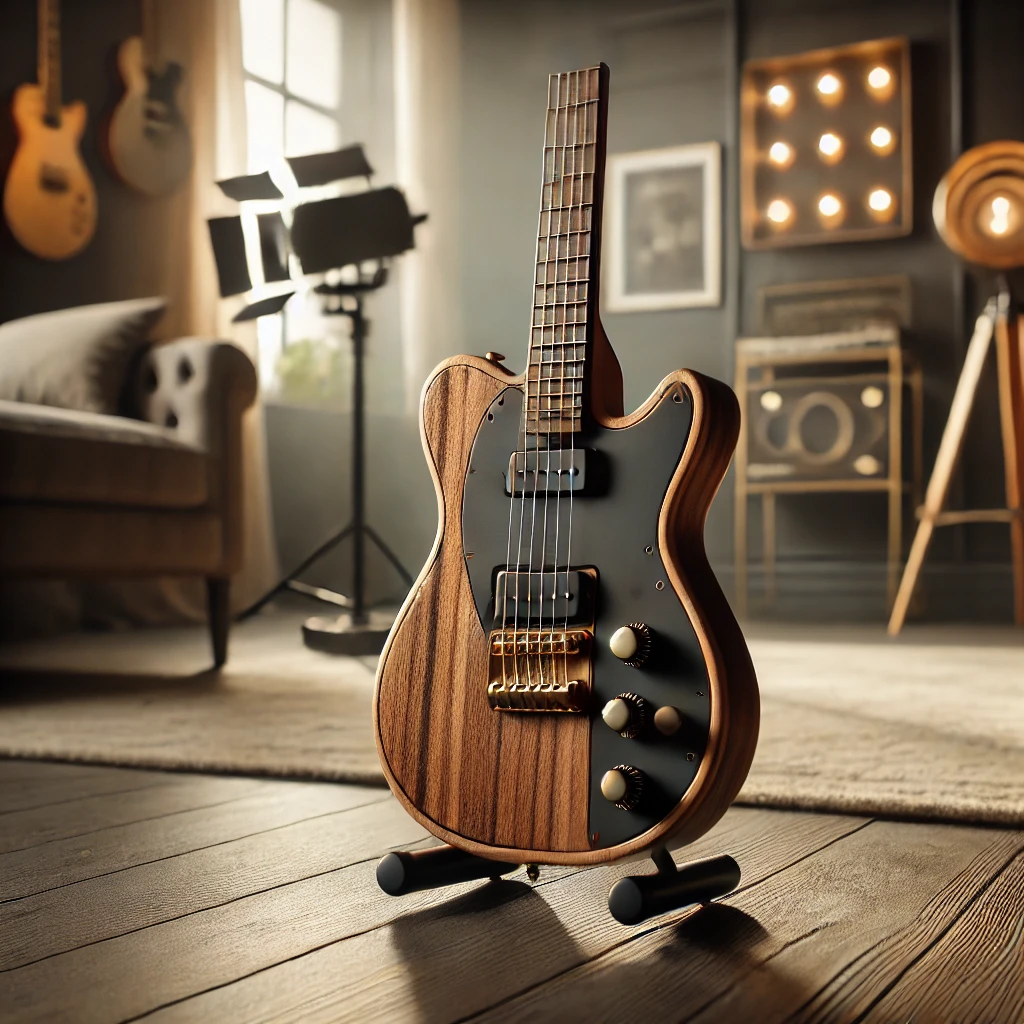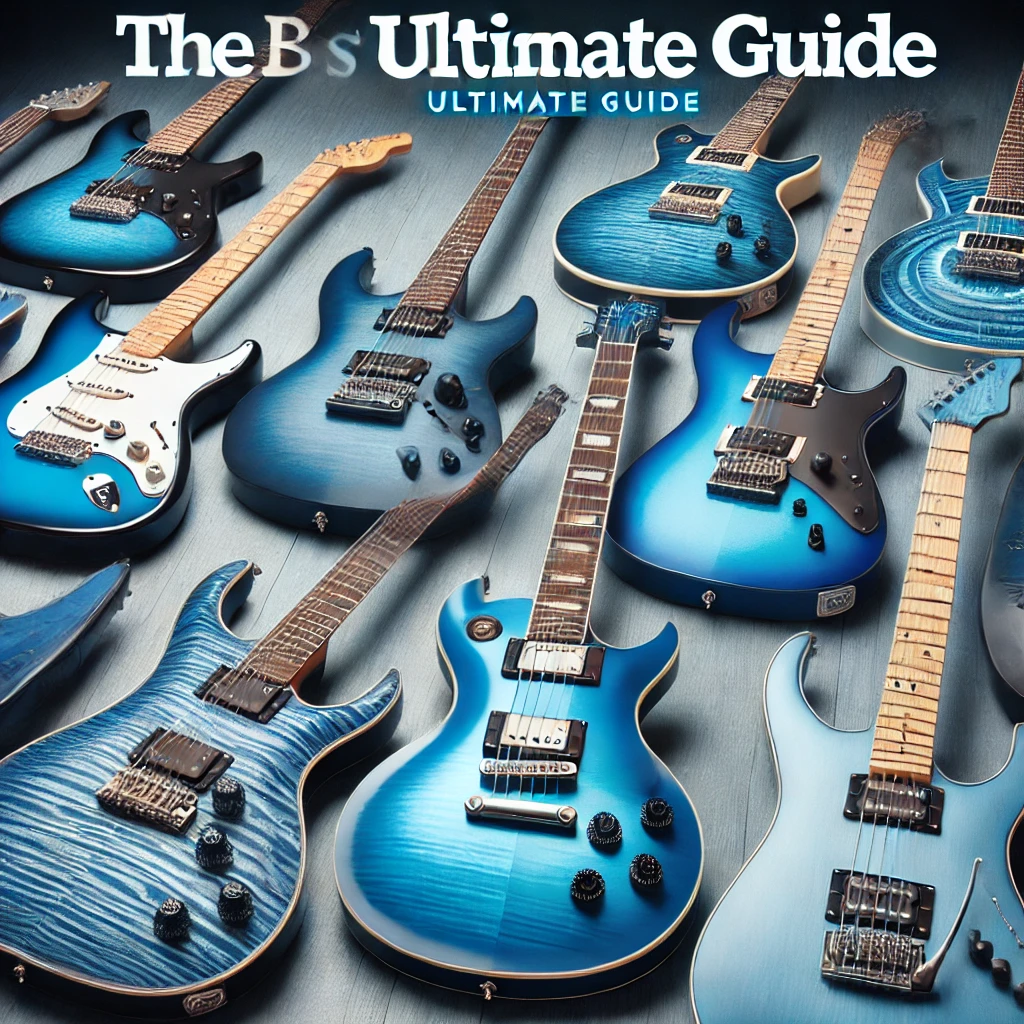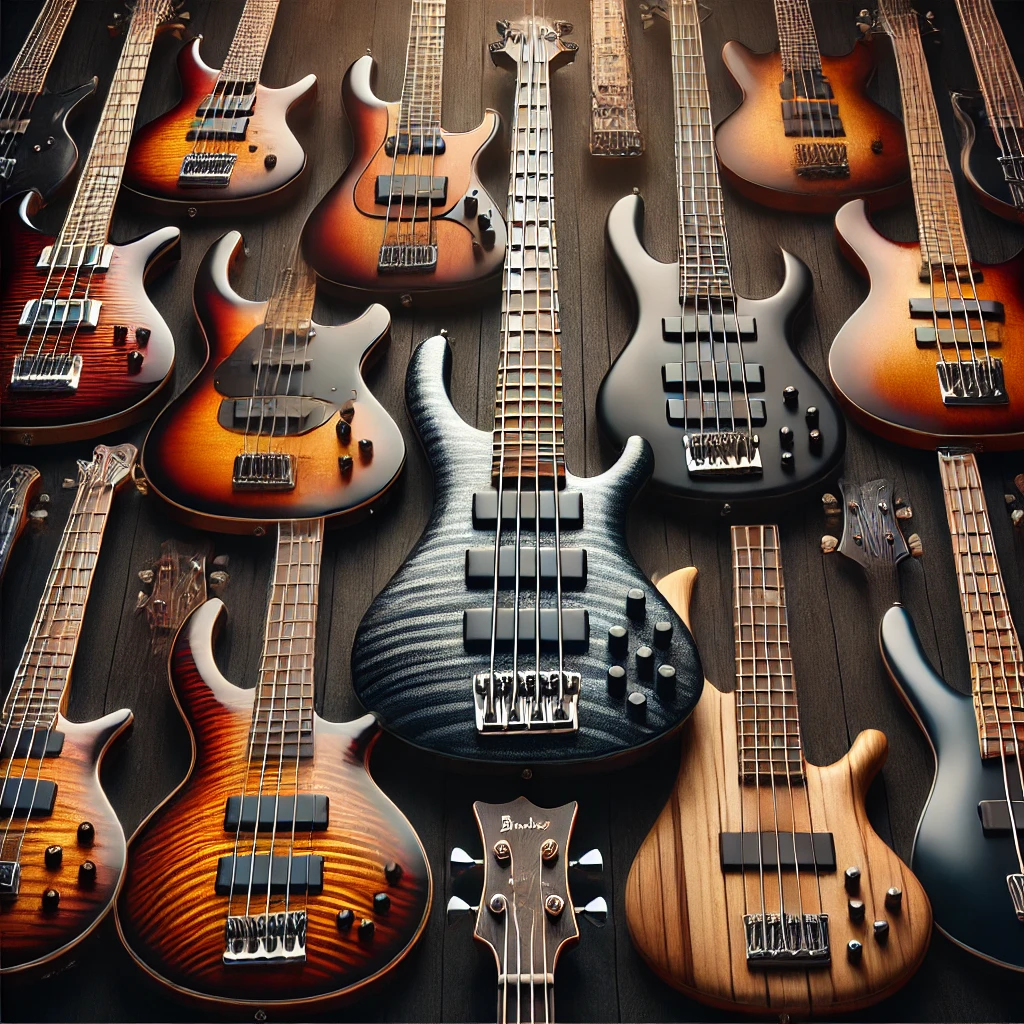The Ultimate Guide to Mini Electric Guitars: Perfect for Travel, Beginners, and Small Spaces
✨ Searching for a mini electric guitar that delivers big sound in a compact package? You’re not alone! As someone who’s been playing and collecting guitars for over 15 years, I’ve witnessed the remarkable evolution of these portable powerhouses. Mini e guitars have revolutionized how musicians practice, travel, and perform, offering incredible versatility without sacrificing quality. Whether you’re a beginner looking for your first instrument or a seasoned player seeking a travel companion, these pint-sized axes deserve your attention. In this comprehensive guide, we’ll explore everything you need to know about mini e guitars, from their unique benefits to the top models currently available on the market.
What Exactly Is a Mini Electric Guitar? 🎸
Before diving deeper, let’s clarify what makes a mini electric guitar different from its full-sized counterparts. Essentially, a mini e guitar is a scaled-down version of a standard el guitar. However, there’s more to these compact instruments than just their diminutive size.
Key Characteristics of Mini Electric Guitars
- Scale Length: Usually between 19-22 inches (compared to 24.5-25.5 inches on full-sized guitars)
- Body Size: Approximately 75-80% the size of standard electric guitars
- Weight: Typically 3-5 pounds (versus 7-9 pounds for regular electric guitars)
- Portability: Designed for easy transport and storage
- Sound: Full electric capabilities with slightly different tonal characteristics
Mini electric guitars aren’t simply toys or novelty items. In fact, many professional musicians incorporate these compact instruments into their setups for various practical reasons. Furthermore, advances in manufacturing and electronics have dramatically improved the quality and playability of mini electric guitars in recent years.
Why Choose a Mini Electric Guitar? ⚡
There are numerous compelling reasons to add a mini electric guitar to your collection. Let’s explore some of the most significant benefits these portable instruments offer.
Portability and Convenience 🧳
The most obvious advantage of a mini electric guitar is its portability. I remember when I first took my ST-Traveler Mini Electric Guitar on a cross-country flight. Unlike with my full-sized instruments, I didn’t have to worry about checking it or fighting for overhead bin space. The guitar fit easily under the seat in front of me, and I was able to practice in my hotel room without disturbing neighbors due to its smaller sound projection when unplugged.
Mini electric guitars are perfect companions for:
- ✅ Travelers and touring musicians
- ✅ Commuters who want to practice during lunch breaks
- ✅ Hikers and campers who want to bring music to remote locations
- ✅ Anyone living in a small apartment or shared space
Ideal for Beginners and Young Players 👶
Another major advantage of mini e guitars is their suitability for beginners, especially younger players or adults with smaller hands. The reduced scale length means:
- Shorter distances between frets, making chord shapes easier to reach
- Lighter weight, reducing fatigue during practice sessions
- Less string tension, making string bending and fretting easier
- More comfortable playing experience overall
Many parents choose mini e guitars as starter instruments for their children. Similarly, adult beginners often find these smaller guitars less intimidating and more comfortable to learn on.
Perfect for Small Spaces 🏠
Living in a cramped apartment or dorm room? A mini e guitar is an excellent solution. These compact instruments take up significantly less space than their full-sized counterparts, making them ideal for:
- ✅ Small apartments and studios
- ✅ Dorm rooms
- ✅ Mobile homes and RVs
- ✅ Shared living spaces
- ✅ Home recording setups with limited space
Additionally, mini electric guitars can be more easily stored in closets, under beds, or mounted on walls without dominating the room.
Unique Tonal Characteristics 🎵
While mini electric guitars are designed to emulate the sound of full-sized instruments, they often possess unique tonal qualities that some players find appealing. The shorter scale length and smaller body can result in:
- Slightly warmer, midrange-focused tones
- Different harmonic content when playing higher up the neck
- Distinctive response to effects pedals
- Unique resonance characteristics
These tonal differences aren’t necessarily disadvantages—many players specifically seek out mini e guitars for their distinctive sound. In fact, several notable musicians have used mini electric guitars to achieve specific sounds on recordings.
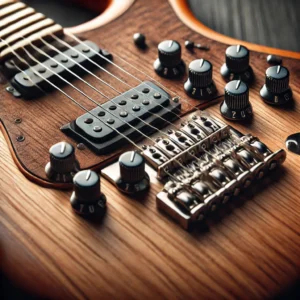
Top Mini Electric Guitars Available Today 🔥
After testing dozens of models and consulting with other guitar enthusiasts, I’ve compiled a list of the best mini e guitars currently available. These selections balance quality, playability, and value.
Best Overall: Ibanez GRGM21 Mikro Electric Guitar
The Ibanez Mikro stands out as perhaps the most respected mini e guitar on the market today. With a 22.2-inch scale length, it strikes an excellent balance between compactness and playability. The GRGM21 features:
- Maple neck with jatoba fretboard
- Poplar body with contoured edges for comfort
- Two powerful Infinity R humbucking pickups
- Hardtail bridge for stable tuning
- Available in multiple finishes
What makes the Ibanez Mikro exceptional is its serious approach to quality. Despite its smaller size, it feels and plays like a professional instrument. The neck profile is comfortable for both small and average-sized hands, and the pickups deliver impressive tone across various genres.
Best Budget Option: Donner DST-100R Mini Electric Guitar
For beginners or budget-conscious players, the Donner DST-100R offers remarkable value. This Stratocaster-style mini e guitar features:
- 22.5-inch scale length
- Solid basswood body
- Maple neck with C profile
- Three single-coil pickups with 5-way switch
- Tremolo bridge system
- Complete starter kit including amp, bag, capo, and accessories
The Donner DST-100R sounds surprisingly good for its price point and comes with everything a beginner needs to start playing immediately. While it may not match the quality of higher-end options, it’s an excellent entry point into the world of mini e guitars.
Best Premium Choice: Traveler Guitar Ultra-Light Electric
For those willing to invest in a premium mini e guitar, the Traveler Guitar Ultra-Light Electric is hard to beat. This innovative instrument weighs just 3 pounds and features:
- Full 24.75-inch scale length in an ultra-compact body
- Built-in headphone amp with aux input
- Detachable lap rest for comfortable playing
- Custom high-output pickup
- Solid maple construction throughout
The Traveler Guitar Ultra-Light takes a different approach to miniaturization, maintaining a full-scale neck while dramatically reducing the body size. This makes it perfect for experienced players who want the feel of a standard guitar in an ultra-portable package.
Best for Kids: Squier Mini Stratocaster Electric Guitar
Fender’s Squier division offers the Mini Stratocaster, which is perfect for young players. This 3/4-sized Stratocaster features:
- 22.75-inch scale length
- C-shaped maple neck
- Three single-coil pickups
- Vintage-style tremolo bridge
- Lightweight construction ideal for young players
The Squier Mini Stratocaster benefits from Fender’s legendary design expertise, resulting in an instrument that’s both accessible for beginners and capable of producing authentic Stratocaster tones.
Comparison: Top Mini Electric Guitars Head-to-Head
| Model | Scale Length | Pickups | Weight | Best For | Price Range |
|---|---|---|---|---|---|
| Ibanez GRGM21 Mikro | 22.2″ | 2x Humbuckers | 5.5 lbs | Overall performance | $$$$ |
| Donner DST-100R | 22.5″ | 3x Single-coil | 4.5 lbs | Beginners on budget | $$ |
| Traveler Guitar Ultra-Light | 24.75″ | 1x Custom | 3 lbs | Travel & professionals | $$$$$ |
| Squier Mini Stratocaster | 22.75″ | 3x Single-coil | 5 lbs | Young players | $$$ |
🔥 Ready to find your perfect mini guitar companion? Check out these top-rated models on Amazon now and start your musical journey with the ideal portable instrument! Don’t miss out on current discounts available for a limited time.
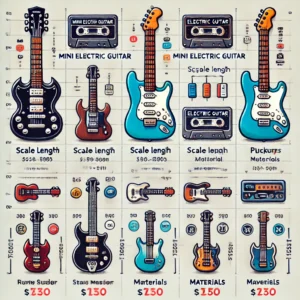
How to Choose the Right Mini Electric Guitar 🧠
Selecting the perfect mini electric guitar depends on your specific needs and preferences. Here are some key factors to consider before making your purchase:
Intended Use
First, consider how you plan to use your mini e guitar:
- For travel only? Focus on weight and durability
- As a primary instrument? Prioritize sound quality and playability
- For a child? Look for appropriate scale length and weight
- For recording? Pay special attention to pickup quality and tonal characteristics
Your intended use will significantly influence which features matter most to you.
Scale Length Considerations
The scale length of a mini electric guitar has a major impact on its feel and sound:
- Shorter scales (19-21 inches): Easier for small hands, less string tension, warmer tone
- Medium scales (21-23 inches): Good compromise between comfort and traditional feel
- Longer scales (23-25 inches): More similar to standard guitars, familiar spacing
If you’re switching between a full-sized guitar and a mini, you might prefer a longer scale length to minimize adjustment. Conversely, younger players or those with smaller hands may benefit from a shorter scale.
Construction and Materials
Despite their smaller size, quality mini electric guitars should still feature solid construction:
- Look for solid wood bodies rather than plywood or composite materials
- Check neck joint construction (bolt-on, set neck, or neck-through)
- Examine fretwork for smoothness and consistency
- Consider weight—some mini guitars can be surprisingly heavy despite their size
Just as with full-sized instruments, better materials and construction generally translate to better sound and durability.
Electronics and Sound
The electronic components significantly impact a mini electric guitar’s versatility:
- Pickup types (single-coil vs. humbucker)
- Number of pickups and switching options
- Tone and volume controls
- Output jack quality
- Preamp or built-in effects (featured on some models)
Don’t assume that all mini e guitars have simplified electronics—many offer the same pickup configurations and controls as their full-sized counterparts.
Accessories for Your Mini Electric Guitar 🛠️
To get the most from your mini electric guitar, consider these essential accessories:
Mini Amplifiers 🔊
A compact amplifier makes the perfect companion for your mini electric guitar. Models like the Blackstar Fly 3 and Boss Katana Mini offer impressive sound in tiny packages. These battery-powered amps can easily fit in a backpack alongside your mini guitar.
Travel Cases 💼
Protect your investment with a properly sized case. Many standard guitar gig bags are too large for mini e guitars, so look for:
- Cases specifically designed for 3/4 size guitars
- Hard cases for maximum protection during travel
- Padded gig bags with proper dimensions for your specific model
The Gator Transit Series Gig Bag works wonderfully for most mini electric guitars and includes sufficient padding for protection.
Specialized Strings 🎻
While many mini electric guitars can use standard string sets, the shorter scale length may benefit from:
- Lighter gauge strings (9-42 or lighter)
- Strings specifically designed for shorter scale instruments
- Custom string sets for optimal tension and playability
Experimenting with different string gauges can significantly improve your mini guitar’s playability and tone.
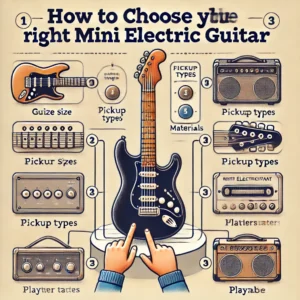
Common Myths About Mini E Guitars Debunked 🔍
Despite their growing popularity, several misconceptions about mini e guitars persist. Let’s address some of the most common myths:
Myth 1: They’re Just Toys
While there are certainly toy guitars marketed to children, proper mini e guitars are legitimate instruments. Companies like Ibanez, Squier, and PRS wouldn’t risk their reputations on inferior products. Modern mini e guitars use the same materials and construction techniques as their full-sized counterparts.
Myth 2: You Can’t Play Them Seriously
Some assume mini e guitars are only for practice or travel. However, many professional musicians use these instruments in live performances and recordings. Their unique tonal characteristics can add interesting textures to music, and their compact size can be an advantage on crowded stages.
Myth 3: They Don’t Stay in Tune
Early mini e guitars did have tuning stability issues, but modern instruments have largely overcome these problems. Quality mini guitars with good tuners stay in tune just as well as standard guitars. The reduced string tension can actually be gentler on tuning machines.
Myth 4: They’re Only for Beginners
While mini electric guitars are excellent for beginners, they’re not exclusively beginner instruments. Many experienced players keep mini guitars in their collection for travel, recording specific sounds, or simply for the joy of playing them.
Famous Musicians Who Use Mini E Guitars 🌟
Several notable musicians have incorporated mini e guitars into their arsenals:
- Ed Sheeran has frequently used reduced-size guitars for both acoustic and e performances
- St. Vincent has been known to play smaller-bodied e guitars during certain tours
- Robert Fripp of King Crimson has utilized compact e guitars in his setup
- John 5 has a signature mini guitar that he uses for specific parts of his live show
These artists demonstrate that mini e guitars can be valuable tools for creative expression, not just convenient alternatives to standard instruments.
DIY Modifications for Mini Electric Guitars 🔧
One of the joys of owning a mini e guitar is the ability to modify it to suit your preferences. Here are some popular modifications:
Pickup Upgrades
The stock pickups in budget mini guitars are often the first components players upgrade. Installing higher-quality pickups can dramatically improve your instrument’s sound. Brands like Seymour Duncan and DiMarzio offer pickups that can fit many mini e guitars.
Hardware Improvements
Upgrading components like tuners, bridges, and potentiometers can enhance both performance and reliability:
- ✅ Locking tuners for better tuning stability
- ✅ Higher-mass bridges for increased sustain
- ✅ Quality potentiometers for smoother volume and tone control
These upgrades can transform an entry-level mini guitar into a professional-grade instrument.
Neck Adjustments
If you find the neck on your mini electric guitar uncomfortable, consider:
- Filing fret ends for smoother playability
- Adjusting the truss rod for optimal relief
- Reshaping the neck profile for better comfort
- Polishing the fretboard for smoother feel
However, I recommend having a professional guitar technician perform these modifications unless you’re experienced with guitar setup and maintenance.
How to Overcome the Challenges of Mini Electric Guitars 💪
While mini electric guitars offer many advantages, they do present some challenges. Here’s how to address the most common issues:
Adjusting to the Scale Length
Moving between standard and mini guitars requires some adjustment. To make the transition easier:
- Practice regularly on both instruments
- Focus on relative positioning rather than absolute finger placement
- Start with simple exercises when switching to a different scale length
- Be patient—your muscle memory will adapt over time
Many players find they can switch between different guitar sizes with minimal difficulty after an adjustment period.
Dealing with Limited Access to Upper Frets
Some mini electric guitars have less accessible upper frets due to their body design. To overcome this:
- Look for models with cutaways or ergonomic body shapes
- Practice alternative fingerings for passages that require high frets
- Consider instruments with “neck-through” designs for better upper fret access
The Jackson JS Series Dinky Minion JS1X offers excellent upper fret access despite its compact size.
Amplification Considerations
Mini e guitars may interact differently with effects and amplifiers:
- Experiment with your amp’s EQ settings to compensate for tonal differences
- Consider using a preamp pedal to shape your tone before it hits the amp
- Try different pickup height settings to adjust output and response
- Be mindful of feedback at high volumes due to different resonant frequencies
With some experimentation, you can achieve excellent tones from a mini e guitar through any amplification setup.
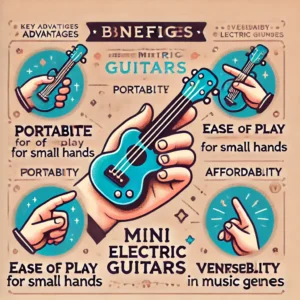
Mini Electric Guitars vs. Travel Guitars: Understanding the Difference 🤔
People often confuse mini e guitars with travel guitars, but there are important distinctions:
- Mini Electric Guitars: Scaled-down versions of standard e guitars, usually with shorter scale lengths and smaller bodies.
- Travel Guitars: Guitars specifically designed for portability, often with full-scale necks but radically modified body designs.
Both have their advantages:
- Mini e guitars often feel more comfortable for smaller players
- Travel guitars maintain standard spacing, which can be easier for experienced players
- Mini guitars usually look like smaller versions of familiar designs
Travel guitars often feature innovative folding or detachable componentsYour choice between a mini e guitar and a travel guitar should depend on your specific needs. If maintaining standard scale length is important to you, a travel guitar might be preferable. Conversely, if you want a more compact instrument overall or have smaller hands, a mini e guitar would likely be the better choice.
Recording with Mini Electric Guitars 🎚️
Mini electric guitars can be excellent recording tools with some special considerations:
Unique Tonal Possibilities
The distinct tonal characteristics of mini electric guitars can add interesting textures to recordings:
- They often cut through a mix differently than full-sized guitars
- Their midrange focus can complement other instruments
- Layering mini electric guitar tracks with standard guitar creates rich, complex textures
- Their slightly different harmonic content can add sparkle to clean parts
Many producers keep mini e guitars in their studios specifically for these tonal variations.
Microphone Placement
If recording a mini electric guitar through an amplifier with microphones:
- Position mics slightly closer than you would for full-sized guitars
- Experiment with off-axis placement to capture the right tonal balance
- Consider using smaller amplifiers that complement the guitar’s character
- Try recording with both close and room mics for additional options during mixing
The Audio-Technica AT2020 condenser microphone pairs particularly well with mini e guitars for recording.
Direct Recording
Mini electric guitars can work beautifully with direct recording setups:
- Use a quality preamp or DI box like the Focusrite Scarlett Solo
- Experiment with amp simulation software to find complementary virtual amps
- Consider using modeling technology designed for smaller instruments
- Don’t be afraid to EQ differently than you would a standard guitar
With the right setup, a mini electric guitar can deliver professional-quality recorded tones indistinguishable from full-sized instruments.
Mini Electric Guitars for Different Musical Styles 🎵
Mini electric guitars can work well across various musical genres, though their characteristics may better suit certain styles:
Rock and Metal
The shorter scale length of mini e guitars can make string bending and fast playing easier, which benefits rock and metal players. Many mini guitars designed for these genres feature:
- High-output humbucking pickups
- Flat, fast-playing necks
- Solid body construction for minimal feedback
- Hardware suited for high-gain playing
The ESP LTD M-10 mini guitar excels in rock and metal contexts with its powerful pickups and comfortable neck profile.
Blues and Jazz
The warm, midrange-focused tone of many mini electric guitars suits blues and jazz perfectly. Look for:
- Semi-hollow body designs for increased resonance
- P-90 or vintage-style humbucking pickups
- Quality tone controls for tonal versatility
- Comfortable neck profiles for complex chord work
Mini guitars with these features can deliver authentic blues and jazz tones in a more portable package.
Pop and Country
For pop and country styles that often require crisp, twangy sounds:
- Mini guitars with single-coil pickups offer excellent articulation
- Look for models with good note separation and definition
- Consider instruments with tremolo systems for expressive playing
- Seek balanced tone controls for versatility
The single-coil equipped Squier Mini Stratocaster delivers classic twangy tones perfect for country and pop music.
Teaching Music with Mini Electric Guitars 👨🏫
As a guitar instructor, I’ve found mini e guitars to be invaluable teaching tools, especially for younger students. Here are some advantages they offer in educational settings:
Benefits for Young Students
Mini electric guitars provide several advantages for children learning guitar:
- Reduced weight prevents fatigue during lessons
- Smaller neck accommodates smaller hands comfortably
- Lower string tension requires less finger strength
- More manageable body size builds confidence
- Often more affordable than full-sized instruments
These benefits can significantly improve the learning experience for young students.
Classroom Applications
In school music programs, mini electric guitars offer practical benefits:
- More instruments can fit in limited storage space
- Lower volume when unplugged for classroom management
- Reduced cost allows schools to purchase more instruments
- Suitable for a wider age range of students
- Less intimidating for beginners
Several school districts have adopted mini electric guitars in their music education programs with excellent results.
Maintenance Tips for Mini Electric Guitars 🧹
Proper maintenance ensures your mini e guitar will provide years of enjoyment. Here are some essential care tips:
String Replacement Considerations
When restringing a mini electric guitar:
- Use strings appropriate for the shorter scale length
- Consider lighter gauge strings for easier playability
- Be careful not to overtighten strings on smaller tuning machines
- Change strings one at a time to maintain neck tension
For most mini electric guitars, string sets labeled for 3/4 size guitars work perfectly.
Setup Adjustments
Mini electric guitars may require different setup parameters:
- Neck relief may need to be slightly less than on full-sized guitars
- String action can often be set lower due to reduced string tension
- Pickup height may need adjustment to balance output across all strings
- Intonation should be checked and adjusted whenever string gauge is changed
A professional setup can dramatically improve the playability of any mini electric guitar.
Storage and Travel Tips
To protect your mini electric guitar:
- Store in a case sized appropriately for the instrument
- Consider humidity control, especially for guitars with wooden components
- When traveling by air, loosen the strings slightly to account for pressure changes
- Use padding around the headstock and bridge for extra protection
- Remove batteries from active electronics during long-term storage
With proper care, a quality mini electric guitar can last for decades.
The Future of Mini Electric Guitars 🚀
The mini e guitar market continues to evolve, with several exciting trends emerging:
Smart Integration
Newer mini e guitars are beginning to incorporate digital technology:
- Built-in effects processing
- Bluetooth connectivity for wireless amplification
- App integration for learning and recording
- USB connectivity for direct computer recording
The Jamstik Studio MIDI Guitar represents this new wave of technologically enhanced mini instruments.
Sustainable Materials
As environmental concerns grow, many manufacturers are exploring eco-friendly options:
- Sustainable wood alternatives for bodies and necks
- Water-based finishes with lower environmental impact
- Recycled materials for components and hardware
- Carbon fiber and composite materials for durability and sustainability
These innovations promise to make mini e guitars both more eco-friendly and more durable.
Expanded Tonal Options
Manufacturers continue to develop ways to expand the tonal palette of mini electric guitars:
- Advanced pickup configurations
- Onboard EQ and tone-shaping circuits
- Hybrid acoustic/electric designs
- Extended range options (7-string, 8-string, etc.)
These developments are making mini electric guitars increasingly versatile instruments.

FAQ About Mini Electric Guitars 🤔
Are mini electric guitars good for beginners?
✅ Yes, mini electric guitars can be excellent for beginners, particularly those with smaller hands or younger players. Their reduced size makes them less intimidating, and the shorter scale length typically requires less finger strength. However, they still provide the authentic electric guitar experience necessary for developing proper technique.
Can you play a mini electric guitar through a regular amp?
✅ Absolutely! Mini electric guitars connect to standard guitar amplifiers using regular instrument cables. While they might sound slightly different than full-sized guitars due to their unique tonal characteristics, they’re fully compatible with all standard guitar equipment, including effects pedals and recording interfaces.
How much should I expect to pay for a quality mini electric guitar?
Mini electric guitars vary widely in price, from budget-friendly models starting around $100 to premium instruments exceeding $500. For a balanced combination of quality and value, expect to spend approximately $150-$300 for a mini electric guitar that offers good playability, sound, and durability.
Can adults play mini electric guitars comfortably?
✅ Yes, many adults enjoy playing mini electric guitars, particularly for travel or practice in limited spaces. While players with very large hands might find certain models restrictive, most adults can adapt to the smaller scale without difficulty. Some mini guitars are specifically designed with ergonomics that accommodate adult players comfortably.
Are mini electric guitars only for practice, or can they be used professionally?
Mini electric guitars can absolutely be used professionally. Many recording artists and touring musicians incorporate these instruments into their setups for their unique tonal qualities or practical advantages. With quality amplification and proper setup, a mini electric guitar can sound just as professional as any standard instrument.
Conclusion: Is a Mini Electric Guitar Right for You? 🏆
After thoroughly exploring the world of mini electric guitars, it’s clear these compact instruments offer tremendous value for various players. They combine portability with genuine playability, making them ideal for travelers, beginners, and musicians working in limited spaces.
The best mini electric guitars deliver impressive sound quality that rivals their full-sized counterparts, while offering unique advantages in terms of comfort and convenience. From budget-friendly starter models to premium instruments for professional use, there’s a mini electric guitar suited to nearly every player’s needs and budget.
Whether you’re seeking your first instrument, adding to your collection, or looking for a travel-friendly option, a mini electric guitar deserves serious consideration. The technology and craftsmanship behind these instruments continue to improve, making now an excellent time to explore this exciting category.
🎸 Ready to experience the versatility and convenience of a mini electric guitar? Check out our top recommendations on Amazon today and enjoy free shipping on qualifying orders! Your perfect portable guitar awaits!
More FQAs:
❓ Are mini electric guitars suitable for beginners?
✅ Yes! Mini electric guitars are ideal for beginners, especially children or individuals with smaller hands, due to their reduced size and lighter weight...
❓ Do mini electric guitars produce the same sound as full-sized models?
✅ Not exactly. While mini electric guitars aim to replicate the sound of full-sized models, their smaller size can result in differences in tone and volume...
❓ Can adults play mini electric guitars comfortably?
✅ Yes! Adults can play mini electric guitars, although the smaller scale may require some adjustment in playing technique...
❓ Are mini electric guitars considered toys or serious instruments?
✅ While some mini electric guitars are designed as toys, many models are fully functional instruments suitable for serious practice and performance...
❓ How does the tuning stability of mini electric guitars compare to full-sized ones?
✅ Mini electric guitars may have slightly less tuning stability due to their shorter scale length, but quality models are designed to maintain tuning effectively...
For a visual guide on choosing the right mini electric guitar, you can watch the following video:
This video reviews five top mini electric guitars, highlighting their features, sound quality, and suitability for beginners.
Recommended for You:
- The 7 Best Electric Guitars of 2025: Expert Reviews & Buyer’s Guide
- The 7 Best Acoustic Electric Guitars of 2025: Expert Reviews & Buyer’s Guide
- Electric Guitar Cost: The Complete Guide for Beginners to Pros (2025)
Disclaimer: This article contains affiliate links. If you purchase products through these links, we may earn a small commission at no additional cost to you.

